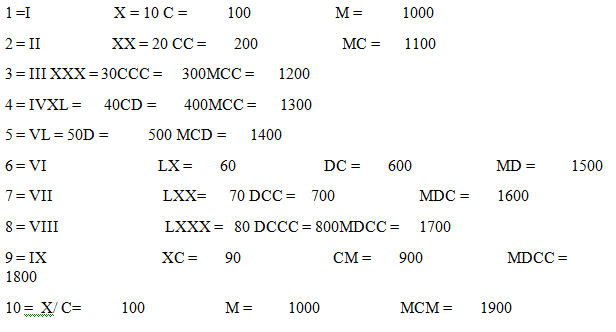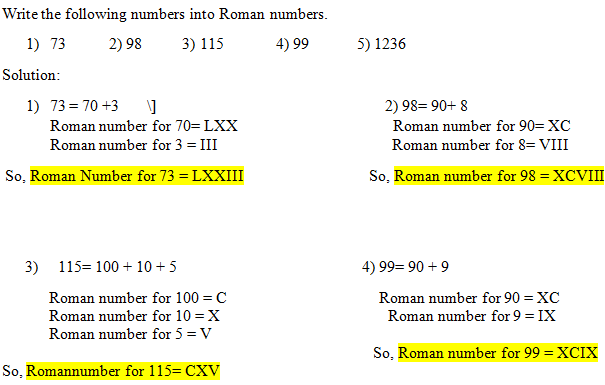- Books Name
- CBSE Mathematics for Class 6
- Publication
- Carrier Point
- Course
- CBSE Class 6
- Subject
- Mathmatics
sudhanshu@kaysonseducation.co.in
CBSE Mathematics for Class 6 > Chapter 1: Knowing Our Numbers > Roman Numerals
Notes Added through teacher account.
- Books Name
- CBSE Class 6 Mathematics Book
- Publication
- Param Publication
- Course
- CBSE Class 6
- Subject
- Mathmatics
ROMAN NUMERALS
One of the earliest systems of writing numerals is the Roman Numeral system. This system is still in use in many places. For example, some faces of clocks show hours in Roman numerals; we use Roman numerals to write numbered list; etc.
Unlike the Hindu-Arabic numeral system, Roman numeral system uses seven basic symbols to represent different numbers. The symbols are as follows :
The Roman numerals :
I, II, III, IV, V, VI, VII, VIII, IX, X denote 1,2,3,4,5,6,7,8,9 and 10 respectively. This is followed by XI for 11, XII for 12,... till XX for 20. Some more Roman numerals are :
I V X L C D M
1 5 10 50 100 500 1000
The rules for the system are :
(a) If a symbol is repeated, its value is added as many times as it occurs: i.e. II is equal 2, XX is 20 and XXX is 30.
(b) A symbol is not repeated more than three times. But the symbols V, L and D are never repeated.
(c) If a symbol of smaller value is written to the right of a symbol of greater value, its value gets added to the value of greater symbol.
VI = 5 + 1 = 6, XII = 10 + 2 = 12 and LXV = 50 + 10 + 5 = 65
(d) If a symbol of smaller value is written to the left of a symbol of greater value, its value is subtracted from the value of the greater symbol.
IV = 5 – 1 = 4, IX = 10 – 1 = 9
XL = 50 – 10 = 40, XC = 100 – 10 = 90
(e) The symbols V, L and D are never written to the left of a symbol of greater value, i.e. V, L and D are never subtracted.
The symbol I can be subtracted from V and X only.
The symbol X can be subtracted from L, M and C only.
Following these rules we get,
1 = I 10 = X 100 = C
2 = II 20 = XX
3 = III 30 = XXX
4 = IV 40 = XL
5 = V 50 = L
6 = VI 60 = LX
7 = VII 70 = LXX
8 = VIII 80 = LXXX
9 = IX 90 = XC
Ex : Write in Roman Numerals
(i) 69 (ii) 98.
Sol: (i) 69 = 60 + 9 = (50 + 10) + 9 = LX + IX = LX IX
(ii) 98 = 90 + 8 = (100 – 10) + 8 = XC + VIII = XCVIII
- Books Name
- MD AFZAL AHMAD Mathematics Book
- Publication
- MD AFZAL AHMAD
- Course
- CBSE Class 6
- Subject
- Mathmatics
Roman Numbers
Roman Numbers are one of the earlier system of writing numbers. Like I, II, III, IV, V etc.
The Roman Numerals:
I, II, III, IV, V, VI, VII, VIII, IX, X These Roman numbers denote 1, 2, 3, 4, 5, 6, 7, 8, 9, 10 respectively.
Some more Roman Numbers

Rules for the Roman Number System:
1) If a symbol is repeated, its value is added as many times as it occurs.
Like, II is equal to 2, III is 3, XX is 20, XXX is 30, CC is 200, MM is 2000, MMM is 3000 etc.
2) A symbol is not repeated more than three times. But the symbol V, L, D are never repeated.
3) If a symbol of smaller value is written to the right side of a symbol of greater value, its value gets added to the value of greater symbol. Like,
VI = 5+1 =6 VII= 5+2= 7 XIII= 10+3= 13 LXV= 50+10+5= 65CLX= 100+50+10=160
4) If a symbol of smaller value is written to the left of the symbol of greater value, its value is subtracted from the value of greater symbol.
IV = 5-1= 4 IX= 10-1= 5 XL= 50-10= 40 XC= 100-10= 90 CD= 500-100= 400
5) The symbols V, L and D are never written to the left of a symbol of greater value, i.e. V, L and D are never subtracted.
The Symbol I can be subtracted from V and X only.
The symbol X can be subtracted from L, M and C only.
Roman Numbers using these rules

Some Solved Examples.

5) 1236 = 1000 + 200 + 30 + 6
Roman number for 1000 = M
Roman number for 200 = CC
Roman number for 30 = XXX
Roman number for 6 = VI
So, Roman number for 1236= MCCXXXVI
- Books Name
- Class 6 Mathematics Book
- Publication
- ReginaTagebücher
- Course
- CBSE Class 6
- Subject
- Mathmatics
Large Numbers in Practice
Large Numbers can be shown using the place value. It goes in the thrusting order as shown below
8 integers 7 integers 6 integers 5 integers 4 integers 3 integers
centimeter( cm) in used as a unit of dimension of length. We can use this unit for measuring the length of a pen, the range of a book or note booket. but this unit is too big to measure the consistence of a pen. So, we use another unit named as millimeter( mm). Also, centimeter and millimeter are veritably small units to measure the length of the wall or a room. We use another unit named as meter for the same. Indeed meter is too small unit when we state the distances between two municipalities or metropolises. For this we need kilometers( km).
The relations between units are
1 kilometer = 1000 meters( m)
1 meter = 100 centimeters( cm)
1 centimeter = 10 millimeters( mm)
Also, we have
100 cm = 1 m = 10mm × 100 = 1000 mm
1000 m = 1Km = 1000 × 100 cm = 100000 cm
100000 cm =1 km = 100000 × 10 mm = 1000000 mm
10 Million = 1 crore
1 million = 10 lakhs
(100,000) Hundred Thousands = 1 lakh
(10,000)Ten Thousands = Thousands Hundreds (1000,000)
We borrow the following rules to compare two large figures
Rule- 1 The number with further integers is lesser than the number with lower integers.
Rule- 2 When two figures have the same number of integers, compare the integers at the leftmost places. The number with the lesser number is lesser. If the integers at the leftmost places are the same also compare the coming integers and so on.

 Carrier Point
Carrier Point
 ReginaTagebücher
ReginaTagebücher
